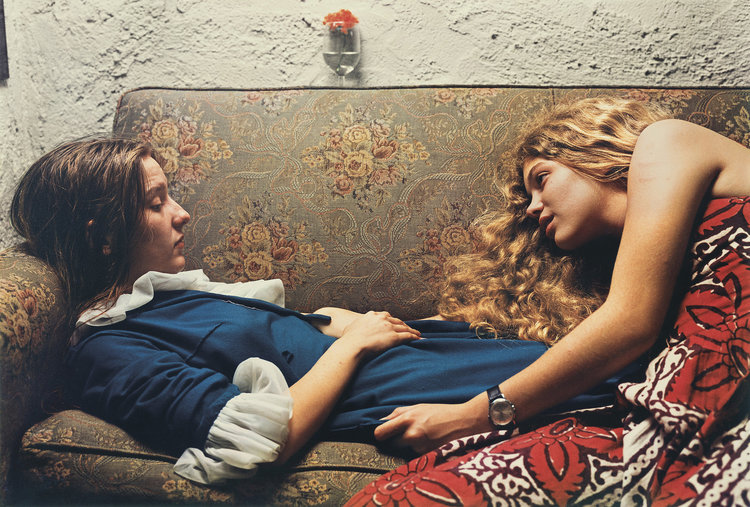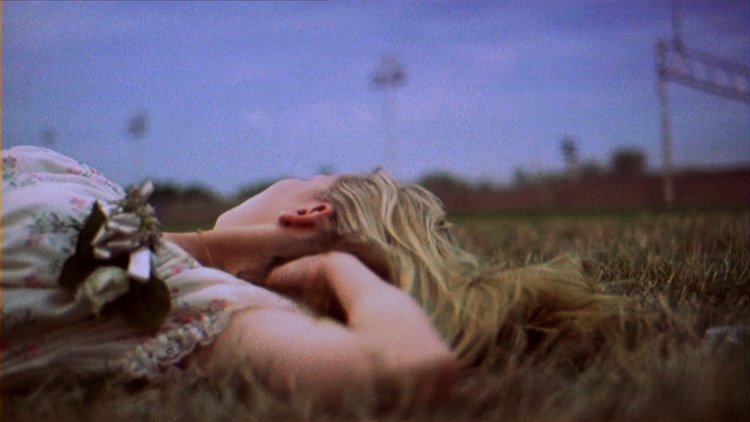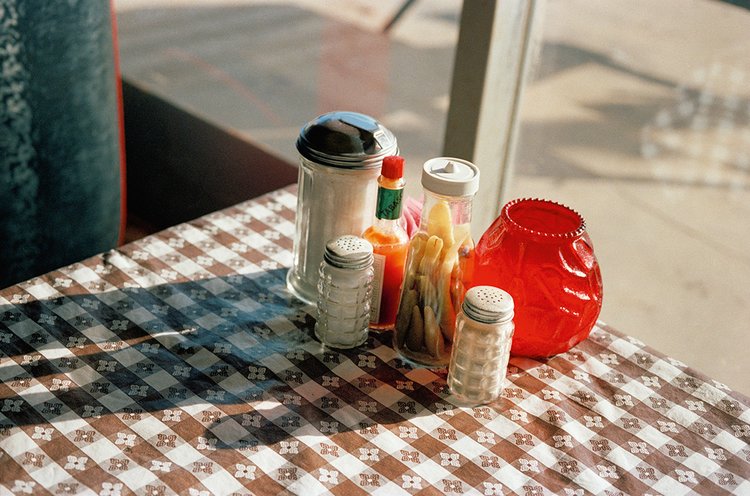Art Encounters | William Eggleston in Cambridge
More from the Art Encounters series can be found here.
Eggleston’s photographs look like they were taken by a Martian who lost the ticket for his flight home and ended up working at a gun shop in a small town near Memphis. On the weekend he searches for the ticket – it must be somewhere – with a haphazard thoroughness that confounds established methods of investigation
– Geoff Dyer.
This is a story:
I spent last week hopscotching around England: London for a few days, Norwich for a few days, Cambridge for a few hours, and then back to Ireland after a few hours in Standsted. Nothing surprising really. But something weird happened in Cambridge. I had stopped – for only a few hours – on the train from Norwich with the intention of going to see the grave of the great Viennese philosopher Ludwig Wittgenstein. I didn’t make the grave. Something out of the ordinary happened on the way. I had one of those wheeley suitcase things dragging along from behind and a relatively cool (by my standards) leather bag around my shoulder. It was a nice sunny day and I was maybe twenty minutes outside of Cambridge. I could see a whole swathe of people heading in the direction of town, so I took a little skip and run and joined the herd.
I tend to talk a lot to strangers (some say it’s a Sagittarian thing) on the road, as my wife is all too aware. My impulse when I see a swathe of people heading in a particular direction is to tag along behind someone who appears to know what they’re doing and then hope they know what they’re doing when engaging them in chat. And that’s what I did. I got chatting to a woman dragging a bag like me, who was heading into town to check into a hotel to change into wedding gear, before returning to a church we were passing just as we began chatting for said wedding. ‘The wedding is on in there,’ she said pointing to Our Lady and the English Martyrs Church.’ ‘It’s a Catholic wedding?’ I said with some surprise, as I noticed the words ‘Catholic’ on the building. ‘Yes,’ she said, ‘there are Catholics in England.’ I waved goodbye and kept walking when I suspected I had a better idea on how to get into town, only to be a embarrassed when bumping into her again in a park my google map app had directed me towards. We smiled at one another in an awkward way and kept walking. Then the weird thing happened. As I bundled my way in through a crowded pedestrian walkway, dragging my suitcase thing behind me, I felt something brush against the back of my leg. When turning around I was faced with an elderly red-faced man momentarily suspended in midair while standing on a black pushbike, before gravity kicked in and he fell to the ground with a sudden thud. People gathered all around the man as he lay unconscious with his arms spread in front of him. The sixty seconds or so that he lay unconscious on the ground in front of me was like an eternity, as thoughts raced through my head, the dominant one being ‘Oh fuck!’

I also began, curiously enough, to think of a famous photograph by the American art photographer William Eggleston. For the minute the man lay unconscious in front of me, an hallucinatory quality, a spectrum of colour, struck me; it was all like a dream about to take the form of a nightmare. It’s the same quality, that same sense that I associate with Eggleston’s photography and in particular his most famous work Untitled from 1975. A tragic moment seems about to unfold in the picture based on a girl found lying unconscious on grass. It is a ‘before’ moment Eggleston captures with intense beauty. Although I read about Eggleston’s photos as capturing before-tragedy moments, I had never joined the dots until this day in Cambridge. I failed to understand this idea until a chunk of my own future seemed to hinge on this man waking up. My mind was racing, my ‘oh fuck’ premised on a future where I was a witness subject to all the bureaucracy of witnessing this tragedy I believed was unfolding in front of my eyes. The joy of walking into the town in the morning sun had halted. All I could think of was the stress, grief, sadness; all those feelings that come to fruition when life changes dramatically in a moment. And just as the girl with her eyes closed on the grass in Eggleston’s famous work is presented so that it’s unclear whether she’s alive or dead, I looked at this man on the ground, wondering – all the time – whether he was passing from this world into the next. And I was preparing myself for that worst-case scenario, for that tragedy to unfold. Then everything changed in an instant; the man woke up.
[pullquote]Eggleston is an artist who has zoomed in on his surroundings in America’s Deep South to the minutiae, making a project of close documentation also one of extreme artistic endeavour.[/pullquote]He opened his eyes and the woman beside me said aloud ‘he’s awake.’ Then another said ‘he’s in shock.’ After he had got to his feet, and it was now apparent he was dazed, concussed even, he fended off our attempts to call an ambulance, insisting his helmet had bore the brunt of the fall, and his falling unconscious was an unnecessary side effect of this. I suggested that he go home, as opposed to cycling on in the same direction he was going. But he looked at me as if I wasn’t really there, hopped on his bike and went on his way. ‘There’s not much more we can do,’ an elderly woman said as the man’s head bobbed up and down in the traffic and I wondered if he was in his right mind. ‘Maybe I should have taken his phone number…Maybe I crossed into his way’ I said as only to be told ‘No…I saw it all..He was shaky before he even got to you. It was nothing do with you.’ ‘I hope he’s ok,’ I said, as we dispersed into the Saturday morning crowds that were descending on Cambridge town.
I never made it to Wittgenstein’s grave. Instead I wandered around Cambridge in a daze, went to the market where I bought a gourmet Scotch Egg and some kind of Venezuelan sandwich with what appeared to be fried bananas but wasn’t, before relocating to a pub beside the round church that served cheap ale. I rang my mother and she put my mind at ease. I then began to put the experience to bed, wondering – all the while – why I always assume the worst is going to happen. Why do I catastrophize things, assume that this man was dying in front of my eyes?

I started to think again about the girl on the grass in Untitled, about Eggleston’s work as a photographer, as I walked through the bustle of Cambridge after a few lunchtime pints of ale. Eggleston is an artist who has zoomed in on his surroundings in America’s Deep South to the minutiae, making a project of close documentation also one of extreme artistic endeavour. He is also the first artist working with photography to make colour a legitimate medium of choice, pioneering art photography from the 1970s. His solo show at MoMA in 1976 was a watershed moment in photography; the moment when colour photography was finally accepted as a legitimate medium of high art. But all of this can be found out easily by typing his name in a Google search. You can also learn about his influence on bands like Primal Scream and Big Star, as well as filmmakers such as David Lynch and Sofia Coppola (see The Virgin Suicides). But why I thought of Eggleston wandering around dazed in Cambridge is what interests me now.
William Eggleston’s Guide sits on my desk as I write this. I’ve been drawn to his photographs for years. But it was only when reflecting on my experience in Cambridge, when this man lay on the ground unconscious, stretched out like the girl in Eggleston’s Untitled, that I suddenly believed I got what Eggleston is all about as an artist; or at least I believed that I got what this picture among others is all about. There are certain moments in our life when time seems to stretch out in front of us like an eternity, that the moment is ongoing as Geoff Dyer says of key photographic works. Everything seems to hinge on what will happen after this moment when our senses are excited. When we’re in this moment, and waiting for eyes to open as I was, all the detail of life appears to us up close: the colour and patterns that make up the world.
Eggleston’s picture of the girl on the grass, as it is known, really captures this experience for me. A young girl lies outstretched on a patch of grass with a camera in her hand, yet it is not clear whether she is alive or dead. The camera in her hand is pregnant with pictures, but we don’t know if she’ll ever see them. It is a typical Eggleston composition in that the perspective is a little off, lending an unfamiliar balance to the picture. Moreover, the combining colours draw us in, towards the intricate pictorial elements in their detail: the dress, the hair, the camera. We are sucked in by detail: the weaving patterns and imprints of a dress, reflecting the auburn hair, while repressing the thought the image engenders: is the girl dead? The truth is we can never know if she is or not. As a result the picture captures the experience of waiting to see; that moment before we slide – often against our will – into the horrible ‘after.’ It is a feeling of being in this moment forever, even though, or – maybe because – the image of what comes after is being pushed away so forcefully. Not just Untitled 1975, but Untitled 1974, captures this sense of a terrible event about to unfold, and clashes with the sensuous beauty of an image of life captured in time.
[pullquote]…colour is an elemental part of his work. Sensation is so often experienced as an increased awareness of colour, hallucinatory-like effects that make us see things clearly.[/pullquote]It was moments such as these, moments that seem to extend into infinity – an Eggleston moment – I experienced on that day in Cambridge. I can still picture the man laid out on the footpath, his red lips shining against the bright variations of grey in his face, and the metallic black of the bike that shone so bright in the sun. Eggleston translates moments like these into photographs. And this is why colour is an elemental part of his work. Sensation is so often experienced as an increased awareness of colour, hallucinatory-like effects that make us see things clearly.
Later that day in Cambridge I dragged my baggy things back to the station, and thought about my earlier experience in the context of how we relate to art more generally. I was trying to think whether my experience helped me to see Eggleston photographs differently, or whether Eggleston gave me the tools to understand my experience. Having arrived at the station, I grabbed a coffee and a sandwich and as I stood waiting for the train to arrive, I found myself overwhelmed with relief. I began crying tears of joy. The catastrophe that I always think is just round the corner, had stayed just around the corner, and the opening eyes of a stranger had helped open my eyes.

